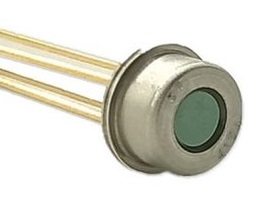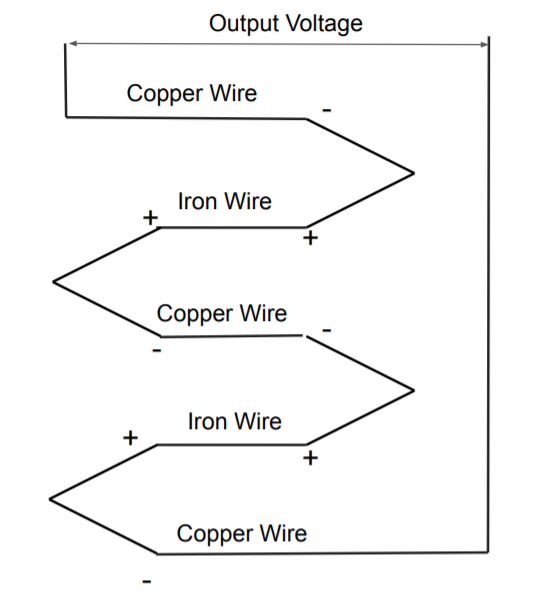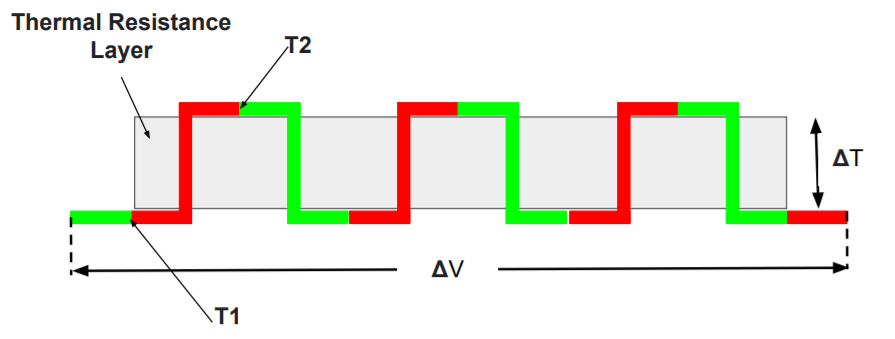Temperature sensors are used to measure and control the temperature. Therefore they have applications in the home & industrial air conditioning control units, manufacturing process control, smartphones, and electronic products. Thermopile is a type of temperature sensor that utilizes thermal energy to measure temperature.
This article covers the advantages, limitations, applications and working of thermopile temperature sensor.
What is a Thermopile Temperature Sensor?

A Thermopile temperature sensor consists of multiple thermocouples connected in series or parallel that convert thermal energy into electrical energy or output voltage.
In other words, a thermopiles convert object radiation energy into electrical energy. Afterward, the electronics system measures this output voltage to determine the body temperature.
Advantages
Here is the list of thermopile temperature sensor advantages.
- It can measure temperature without coming in contact with the hot body.
- Low cost
- It can measure a moving body temperature.
- Compact size
- They do not consume external power.
- Stable response characteristics.
Limitatons
- They are susceptible to noise from external environments.
- Environmental temperature can impact thermopile temperature measurements.
- They are not suitable for the dusty environment.
Applications
Here is the list of the applications of Thermopile-temperature-sensors.
- They are used for Non-contact temperature measurement.
- Measure temperature in consumer electronics products such as microwave ovens, car climate control, mobile phones, etc.
- They are used in Infrared thermometers as the temperature sensing elements.
- Used in HVAC systems to measure environment temperature.
- Monitor process temperature.
How does a Thermopile Works?
Construction

The above image shows that a thermopile consists of multiple thermocouples arranged in series to get high output voltage. Thermocouple hot and cold junctions are isolated to improve measurement accuracy.
Working Principle
A thermopile works on the principle of the thermoelectric effect.
According to the thermoelectric effect, a thermocouple produces an electric voltage due to the temperature difference at the two ends.
Thermocouple output voltage (mV/K) depends on its thermoelectric / Seebeck coefficient.

Single thermocouple output voltage with temperature difference is small and is very difficult to measure. Therefore multiple thermocouples are arranged in series or parallel to get a high output signal.
Higher the output voltage more accurately we can measure the object temperature.
Output Voltage Calculation Formula
Thermocouple Output Voltage = S x Temperature Difference
Thermistor Output Voltage = S x N x Temperature Difference
Where
S – Seebeck Coefficient
N – Number of Thermocouples
From Where we can Buy Thermopile-Sensors
Refer below link for the manufacturer and suppliers for thermopile-temperature-sensors and modules.
Thermopile vs Thermocouple : What is the Difference
| Parameter | Thermopile | Thermocouple |
|---|---|---|
| Construction |
 |
 |
| Thermocouples are connected in series or parallel. | Thermocouples temperature sensors consist of two junctions (Hot and Cold Junctions) of dissimilar metals welded together. | |
| Output Voltage | V = S * N * ΔT | V = S * ΔT |
| Senstivity | Low | High |
| Output Voltage | High | Low |
| Size | Thick | Small and Compact |
| Applications | Non-Contact Temperature Measurements | Contact Based temperarure Measurements |
Frequently Asked Questions
They are electronic devices that can convert the radiation energy into electrical energy or voltage output. Higher the radiation energy higher will be the voltage output.
Therefore this property is used to measure an object or body temperature.
Thermopiles are multiple thermocouples connected in series or parallel. In this way we can increase the output voltage.
Mostly thermocouples are connected in series in a thermopile to increase the voltage output. In this way, voltage output increases with a very small change in temperature. This improves thermocouple accuracy.
For small scale it may be possible but not at large scale.
To sum up, thermopiles consist of multiple thermocouples arranged in series or parallel to convert the object’s radiation energy into electrical voltage. We suggest you read this article on machine monitoring systems used on the manufacturing lines.

Add a Comment